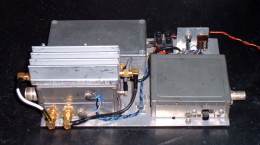
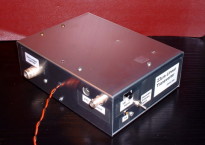
23cm is a fascinating band: it's the most accessible of our Amateur microwave allocations, with some commerically-available equipment around, but it's also a good starting-ground for microwave home-construction.
I had an Icom IC-T81E handie (for 6m, 2m, 70cm & 23cm) for a while, but my main equipment has always been a home-built transverter, which I made in 1996 and eventually (after 11 years) got around to putting into a "proper box":


So now I can take it out portable without the worry of it all coming to pieces in my hands!
My transverter takes an input of 2.5W on 2m, to produce 1.5W on 23cm. It will handle any mode from my FT817, and it also includes a -6MHz shift for operating through the repeaters. I also developed a combined 20W PA and pre-amp, designed to be fitted remotely, as close as possible to the antenna (usually an old Jaybeam 15-over-15 dual yagi).
At first I operated this transverter from the G3KAC Club Station in Bristol and from various portable sites, but after returning to Bolton in 2005, I found activity in this area too: 2005, 2006, 2007.
| In July 2009 I bought one of the first batch of the Alinco DJ-G7E handies imported into the UK.
This is a handie with 2m, 70cm and 23cm, and is the first to include 23cm since the IC-T81E ten years ago. Read more about my experiences with this exciting new set here and see how I've used it mobile here. And follow my patch antenna development here. |
 |
One of the difficulties with operating nets on this band is that high-gain (and hence narrow beamwidth) antennas are often used. This means that in nets of three or more stations it can sometmes be difficult to find optimum beam-headings so that eveyone can hear one another.
Another problem is that a few FM-only stations use vertical polarisation, whereas those with multimode capability are set up for horizontal. My Jaybeam antenna can only be mounted horizontally, but I can tip my LQY over to slant-polarisation if required.
I also made an axial-mode helix antenna, which produces circular polarisation, and should give "just 3dB" loss with any linear polarisation. I used 2mm enamelled copper wire for the element, 22mm plastic conduit for the boom, and found a gauze kitchen splatter-screen which was just the right size for the reflector!


Many years ago I acquired a set of four 27-ele G3JVL loop-quads, one of which I still have. It's built on a circular boom, and so is very easily tipped over for slant polarisation. Andy G1HBE also uses this polarisation, which is a good compromise for either vertical or horizontal signals, even if it does look as if the wind has blown the antenna over!
In 2009 I donated another of these to the Bolton Wireless Club for their portable operations.
Another design is a double bi-quad, whose broad beamwidth provides an obvious advantage in multi-way nets with stations on different headings.
As my home QTH is surrounded by higher ground, so the majority of my DX 23cm contacts were made when operating portable from the nearby hills. However, one of my best-ever contacts on 23cm was over 650km into Germany from home, during a troposhperic "lift" in February 2006.
But from home I can usually detect (using SSB mode) the GB3SE (Stoke-on-Trent) repeater/beacon and I've occasionally heard (when conditions were helpful) the GB3MHL (Ipswich) beacon too.
Another interesting aspect of the band is the strong reflections from structures (e.g. local gasworks and old mill buildings) which can sometimes help signals to get around obstructed paths. As an example, I can only work MW1FGQ (who is South-West of me) from home by using reflections - the best signal I've heard from John was when I was beaming East, pointing at Bolton Town Hall!
As can be seen from this chart of contacts per year, the acquisition of fresh equipment for the band made 2009, 2010 and 2019- bumper years for me on 23cm:
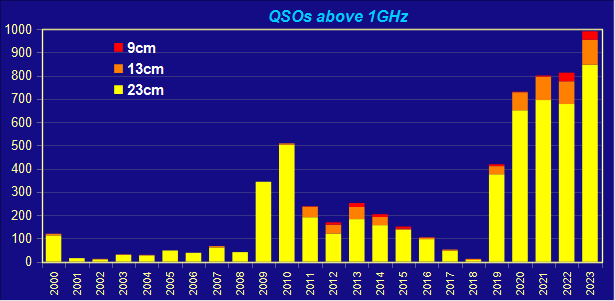
Although all my long-distance SSB contacts were made during contest sessions and tropo openings, I've also been keen to get more local contacts (particularly on FM) too. I know quite a few stations in this area who have 23cm capability but hardly ever use it: this is a shame considering the effort they went to to get on the band in the first place!
Here's my list of local (to NW England) stations with 23cm capability with whom I've spoken on air in 2008-10.
It's worth keeping an eye on the SOTA-Watch site for 23cm activity from local hilltops in the Peak District, Pennines and North Wales. And have a listen during the scheduled contest sessions from the RSGB, IARU & UK Microwave Group which include 23cm.
For the Spring of 2009, Shaun G7IEI kindly loaned me his Yaesu FT911 handie, which I used portable from the hills on more than a dozen occasions. Each time I had at least one answer to my CQ calls, and I then managed most of the QSOs on 100mW power (to reduce battery drain)!
And Wayne 2E0BVJ has also had some contacts using an old Standard C568, which provides a mere 35mW on the band.

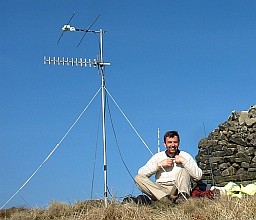

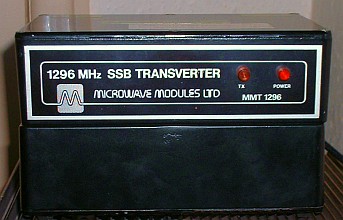
In Summer 2009, the Bolton Wireless Club acquired an old Microwave Modules transverter and I donated a loop-quad antenna for Club use, so that more of our members can try out the band for themselves.
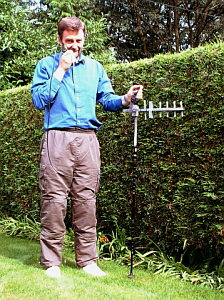 |
I've tried some compact aerials for convenient hilltop operating: something small enough to be carried in my rucsack, and then clip onto the top of my walking-stick, which can serve as a small mast.
The first rough prototype of a 6-ele beam proved the mechanical concept (and on a calm day didn't even need any additional support other than the pointed end of the stick pushed into the ground). Then I developed a portable patch antenna which has less gain, but is much more robust and convenient to carry in my backpack. |
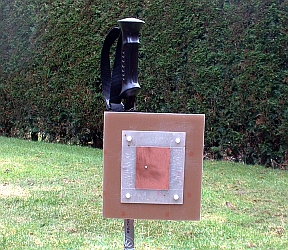 |
| In December 2009 I enjoyed the loan of a Yaesu FT736 with the 23cm module fitted. This provides around 10W output from a fully-featured base-station set. Many thanks to David G8UVE for letting me have a play with it, and also for allowing Chris G4HYG to borrow it to score more points for the Bolton Wireless Club, and help them to win the RSGB 23cm Club Championship. | 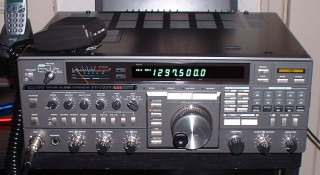 |
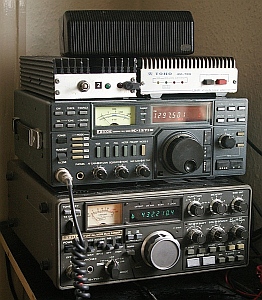 |
Then in March 2010 I acquired a "proper" 23cm radio of my own - an old Icom IC1271E - a large "mobile" multimode (although it includes an internal mains PSU, it will run direct from 12V too). This set used to belong to my late friend Dave 2E0DCR, so it now takes pride of place in my shack.
My first QSOs with this set were in the UK Microwave Group's "Low-bands" contest in March 2010 - I had four contacts operating from a friend's QTH in the Wye Valley. Then in June I had 20 QSOs from Winter Hill, including one down into Wiltshire. And then in December 2010, I got the matching Icom GaAsFET masthead pre-amp for it, which meant I could hear a lot more signals (but not necessarily stations who can hear me!) |
I've also operated FM-ATV on 23cm: details of this can be found here.
In February 2019 I repaired my Icom preamp (it just had a sticky relay), and got back on the band with renewed enthusiasm. I reckon that the introduction of the new Icom 9700 (and a consequent boom in second-hand older kit) led to an increase in activity on the band.
At Easter 2019 I bought a 25W PA/pre-amp from SG-Lab (in Bulgaria) and fitted it into a box for installation at the mast-head, where it delivers its output direct to the antenna. Now using my original transverter (or the IC1271 with the drive power backed-off), I can run it at 10W in the Low-power section of the UK Activity Contests.
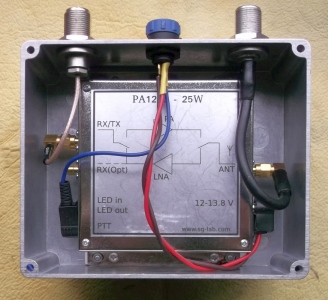
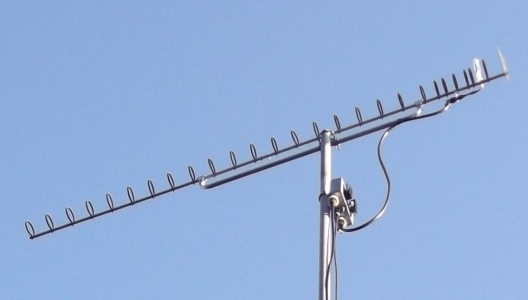
It also works very well with a venerable old IC120 1W FM mobile which I acquired in May 2019: this is the set-up which I use most regularly.
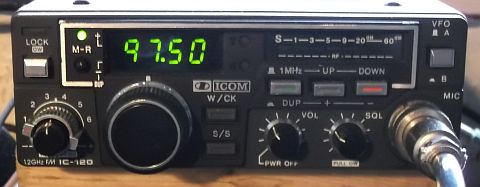
Through 2019, I logged more than 350 QSOs on the band: here's a list of all the stations with whom I made contact. Furthermore, I was surprised to receive an RSGB certificate as the Runner-Up in the Fixed Station section of VHF National Field Day!
And since February 2019 I've been running a regular weekly FM net (around 1297.5) on Wednesday evenings, from 8:30 to 10pm.
Following that, in 2020 I made more than 650 contacts - two thirds of these being on FM and 60 of them using my Alinco handie from the local hills.
Over the year, a total of 26 different stations called in to our Wednesday night FM nets and sometimes we had eight stations on at once.
I managed nearly 700 contacts in 2021, including 50-odd from FM portable operations and 250 on SSB during contest sessions, and seventeen different stations called in to our Wednesday night FM nets through the year.
I maintained this activity through 2022, with 80 from my Alinco up on the hills and by the end of the year we'd clocked up two hundred Wednesday night FM nets (missing only 2 weeks since February 2019).
2023 was my busiest ever year, with well over eight hundred contacts - most of these operating from my home QTH near the bottom of a valley (and using 20W or less). The majority of this activity was outside the contest sessions, including weekly nets with G3OHH, G8DOH & G4HWA at noon on Saturdays (around 1296.2 USB). We've also kept up the Wednesday evening FM nets on 1297.5 (holding our 250th in December 2023), where we use horizontal beam antennas and usually find a combination of headings (employing reflections and side-lobes) to enable an "all-heard" net.
I also enjoyed around 130 portable contacts, using my DJG7 handie running 1W of FM from the nearby West Pennine moors. I find that if I get up there around ten in the morning, I've an excellent chance of catching G4NOY and M0JVW (neither of whom I can reach from home). Most of our activity is simplex (on 1297.5), but we sometimes move onto the GB3SE repeater.
If you'd like to try a sked on 23cm (FM or SSB), then please get in touch.